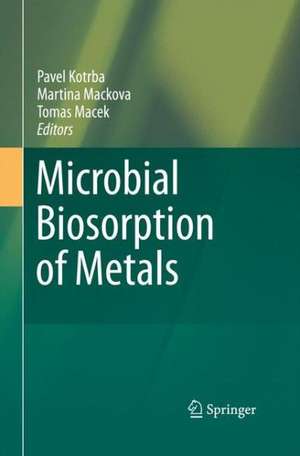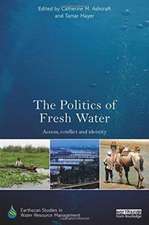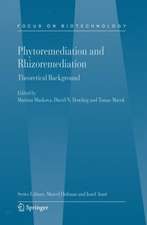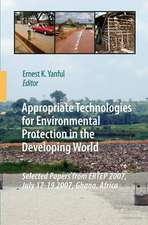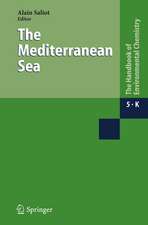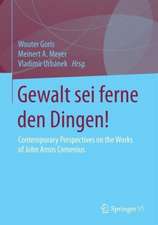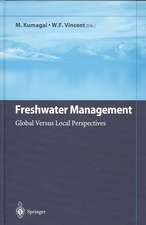Microbial Biosorption of Metals
Editat de Pavel Kotrba, Martina Mackova, Tomas Maceken Limba Engleză Paperback – 25 noi 2014
Biosorption is a general property of living and dead biomass to rapidly bind and abiotically concentrate inorganic or organic compounds from even very diluted aqueous solutions. As a specific term, biosorption is a method that utilizes materials of biological origin – biosorbents formulated from non-living biomass - for the removal of target substances from aqueous solutions. Recent research on biosorption provides a solid understanding of the mechanism underlying microbial biosorption of heavy metals and related elements.
This book gathers review articles analyzing current views on the mechanism and (bio)chemistry of biosorption, the performance of bacterial, fungal and algal biomass, and the practical aspects of biosorbent preparation and engineering. It also reviews the physico-chemical evaluations of biosorbents and modelling of the process as well as the importance of biosorption during heavy metal removal using living cells. It is a reference work for scientists, environmental safety engineers and R&D specialists who wish to further promote biosorption research and use the accumulated knowledge todevelop and build industrial applications of biosorption in heavy metal separation technologies.
| Toate formatele și edițiile | Preț | Express |
|---|---|---|
| Paperback (1) | 930.76 lei 6-8 săpt. | |
| SPRINGER NETHERLANDS – 25 noi 2014 | 930.76 lei 6-8 săpt. | |
| Hardback (1) | 936.81 lei 6-8 săpt. | |
| SPRINGER NETHERLANDS – 16 ian 2011 | 936.81 lei 6-8 săpt. |
Preț: 930.76 lei
Preț vechi: 1135.07 lei
-18% Nou
Puncte Express: 1396
Preț estimativ în valută:
178.18€ • 183.25$ • 147.82£
178.18€ • 183.25$ • 147.82£
Carte tipărită la comandă
Livrare economică 18 februarie-04 martie
Preluare comenzi: 021 569.72.76
Specificații
ISBN-13: 9789400790179
ISBN-10: 9400790171
Pagini: 344
Ilustrații: XI, 329 p.
Dimensiuni: 155 x 235 x 18 mm
Greutate: 0.48 kg
Ediția:2011
Editura: SPRINGER NETHERLANDS
Colecția Springer
Locul publicării:Dordrecht, Netherlands
ISBN-10: 9400790171
Pagini: 344
Ilustrații: XI, 329 p.
Dimensiuni: 155 x 235 x 18 mm
Greutate: 0.48 kg
Ediția:2011
Editura: SPRINGER NETHERLANDS
Colecția Springer
Locul publicării:Dordrecht, Netherlands
Public țintă
ResearchCuprins
Preface.- 1. Microbial Biosorption of Metals – General Introduction.- 2. Potential of Biosorption Technology.- 3. The Mechanism of Metal Cation and Anion Biosorption.- 4. Equilibrium, Kinetic and Dynamic Modelling of Biosorption Processes.- 5. Bacterial Biosorption and Biosorbents.- 6. Fungal Biosorption and Biosorbents.- 7. Algal Biosorption and Biosorbents.- 8. Removal of Rare Earth Elements and Precious Metal Species by Biosorption.- 9. Biosorption and Metal Removal through Living Cells.- 10. Yeast Biosorption and Recycling of Metal Ions by Cell Surface Engineering.- 11. Bacterial surface display of metal-binding sites.- 12. Immobilized Biosorbents for Bioreactors and Commercial Biosorbents.- 13. Magnetically responsive biocomposites for inorganic and organic xenobiotics removal.- Index.
Textul de pe ultima copertă
Heavy metals always pose serious ecological risks when released into the environment due to their elemental non-degradable nature, regardless of their chemical form. This calls for the development of efficient and low-cost effluent treatment and metal recuperation technologies for contaminated waste water, not only because regulatory limits need to be met but also because the waste itself can be a resource for certain precious metals.
Biosorption is a general property of living and dead biomass to rapidly bind and abiotically concentrate inorganic or organic compounds from even very diluted aqueous solutions. As a specific term, biosorption is a method that utilizes materials of biological origin – biosorbents formulated from non-living biomass - for the removal of target substances from aqueous solutions. Recent research on biosorption provides a solid understanding of the mechanism underlying microbial biosorption of heavy metals and related elements.
This book gathers review articles analyzing current views on the mechanism and (bio)chemistry of biosorption, the performance of bacterial, fungal and algal biomass, and the practical aspects of biosorbent preparation and engineering. It also reviews the physico-chemical evaluations of biosorbents and modelling of the process as well as the importance of biosorption during heavy metal removal using living cells. It is a reference work for scientists, environmental safety engineers and R&D specialists who wish to further promote biosorption research and use the accumulated knowledge todevelop and build industrial applications of biosorption in heavy metal separation technologies.
Biosorption is a general property of living and dead biomass to rapidly bind and abiotically concentrate inorganic or organic compounds from even very diluted aqueous solutions. As a specific term, biosorption is a method that utilizes materials of biological origin – biosorbents formulated from non-living biomass - for the removal of target substances from aqueous solutions. Recent research on biosorption provides a solid understanding of the mechanism underlying microbial biosorption of heavy metals and related elements.
This book gathers review articles analyzing current views on the mechanism and (bio)chemistry of biosorption, the performance of bacterial, fungal and algal biomass, and the practical aspects of biosorbent preparation and engineering. It also reviews the physico-chemical evaluations of biosorbents and modelling of the process as well as the importance of biosorption during heavy metal removal using living cells. It is a reference work for scientists, environmental safety engineers and R&D specialists who wish to further promote biosorption research and use the accumulated knowledge todevelop and build industrial applications of biosorption in heavy metal separation technologies.
Caracteristici
Emphasis on current knowledge on microbial biosorption of metals and related elements Covers the biosorption mechanism and kinetics, biosorbent engineering and biosorption process modeling, including a description of suitable methods and tools Compares properties of various biomass types and methods for biosorbent formulation and improvements Integrates information resource for an assessment of industrial applicability Includes supplementary material: sn.pub/extras
